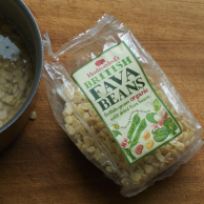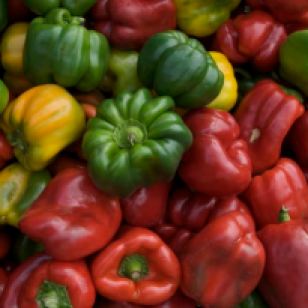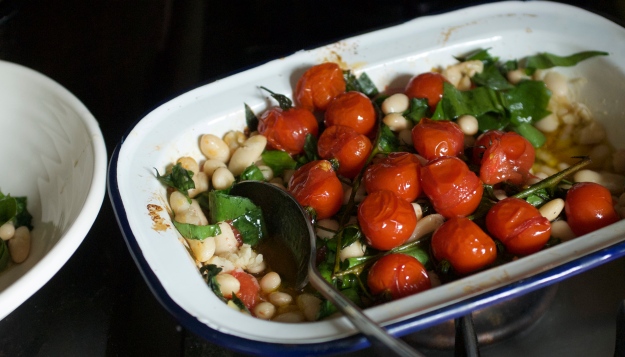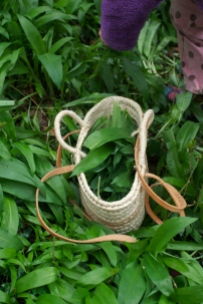
Eating beans certainly doesn’t have to be all about calorie counting as this warm fava bean purée swirled with rich, nutty butter demonstrates. I cooked up the recipe at a recent workshop in London for The Guild of Food Writers and promised to post it.
British beans and peas are enjoying quite a renaissance at the moment thanks to Nick Saltmarsh and the rest of the team at Hodmedods. The fact is that we export vast quantities, thousands of tons in fact, of fava beans (dried broad beans) every year and they taste bloody good, are fantastically nutritious and really economical too. It seems rather fortuitous that we’re developing a taste for cheap, homegrown beans right at this moment, with the pound plunging ever downwards and us setting our country adrift into God knows where, we may well be needing some economical sustenance in the near future (that will be my first and last Brexit comment here otherwise I might just get into a rant).
The dish was inspired by a recipe in the new United Nations FAO cook book, Pulses: Nutritious Seeds for a Sustainable Future (the book can be downloaded here). Turkish chef Didem Senol gives a recipe for warm hummus (made with chickpeas as you would expect) and a hot spicy butter. Here’s a copy of the recipe….

My version used some split fava beans that cook up to a deliciously soft purée in about half an hour with no need for soaking at all. These split beans are great to add to curries and stews to thicken up the sauce (good for the gluten intolerant and also great for those like me who enjoy the creamy texture), they also make the most fabulous falafel. I liked the idea of the melted butter on top as, hoorah, we’re able to ladle on the fat again nowadays without an ounce of guilt (I feel so sorry for those who’ve been suffering margarine or low-fat spread for decades only to discover that it was all a waste of time). So, I was up for the melted butter but thought I’d really pull out all the stops by caramelising it too. If you’ve never tried this before you’ll be amazed; “beurre noisette” is heaven with fish (just add a few capers and a bit of parsley) and even better with pasta (add some sage leaves to crisp up as the butter browns).
Warm Fava Hummus with Caramelised Pistachio Butter
Makes 2 large bowls – ideal for sandwiches, salads, dipping and whatever else you usually do with hummus. The butter only really works with warm hummus, you could always zap it in the microwave just before serving.
250 g split fava beans
1 clove of garlic, crushed
Juice of 1/2 – 1 lemon
100 ml -ish extra virgin olive oil
Salt to taste
50 g unsalted butter
50 g roughly chopped pistachio nuts
Good pinch of Urfa chilli flakes (or any other sweet, slightly smoked chilli)
For the hummus
Take a small pan, cover the fava beans by a couple of centimetres of cold water and then place over a medium heat. Skim off the froth as the beans come up to the boil and then simmer until they begin to soften and collapse into the cooking liquid. Do add a little extra water if needed but only enough to keep the favas from drying out. The idea is to purée the beans and liquid to make the hummus but if they are very wet you could strain through a sieve.
Whizz up the beans with a blender, out board engine (aka handheld blender) or food processor and mix in the garlic, lemon juice, olive oil and salt to taste. You could, of course, serve this minus butter BUT please do give it a go, you may become hooked.
For the butter
Melt the butter in a small saucepan (ideally a steel rather than dark, non-stick pan so that you can watch the colour of the butter changing later).
Turn up the heat until the butter begins to froth and then use your nose; once you begin to get that gorgeous biscuity smell you need to be on your guard. Swirl the pan a little so that you can see what’s going on and once the little flecks of milk solids are turning a foxy red/brown it’s time to quickly tip the butter into a heatproof container to stop it from burning. Too pale and the butter will taste cloying and fatty, too dark and it will taste burnt (just like a sugar caramel).
Stir in the pistachios and Urfa chilli flakes. Swirl the butter over the warm hummus and serve right away with toasted bread.
Split favas are available in many health food shops, deli’s and good grocers now and also online at Hodmedods
Urfa chilli flakes are available at plenty of good spice shops and delis and I found mine online at Sous Chef
DO listen to The Radio 4 Food Programme on 10th/11th July – it’s all about pulses.
Nick Saltmarsh of Hodmedod, Sanjay Kumar of The Cornish Sardine School and I had a wonderful time recording some of the programme with Sheila Dillon in Bristol last week.

















 200 g (ish) cherry tomatoes on the vine
200 g (ish) cherry tomatoes on the vine




 Children are so great at living in the now. I adore this picture of Imi in Bath last weekend. She skips, she sings and can’t resist a bollard- she’ll leap frog it or do a high kick and, whilst I don’t quite have her flexibility (or the flamingo legs to go with it), I can only hope to soak up some of her innocent joie de vivre.
Children are so great at living in the now. I adore this picture of Imi in Bath last weekend. She skips, she sings and can’t resist a bollard- she’ll leap frog it or do a high kick and, whilst I don’t quite have her flexibility (or the flamingo legs to go with it), I can only hope to soak up some of her innocent joie de vivre.


 I’ve chosen this fabulous soup recipe for a couple of very good reasons. As you know if you’re a regular reader of my blog, I am rather obsessed with pulses, chickpeas in particular. Secondly I’ve been challenged by the guys at
I’ve chosen this fabulous soup recipe for a couple of very good reasons. As you know if you’re a regular reader of my blog, I am rather obsessed with pulses, chickpeas in particular. Secondly I’ve been challenged by the guys at 















































